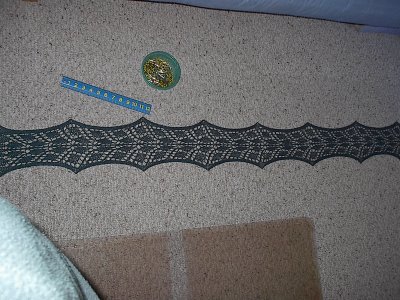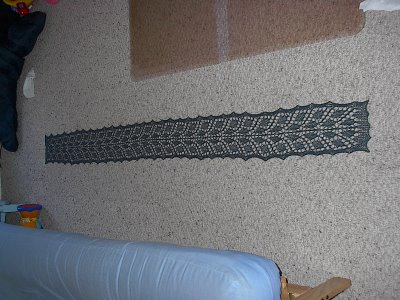See, in decorative lace blocking, you use starch to hold it in shape. All the starch you want. Or even glue. But for wearable lace, you are relying entirely on the fibers to do their thing, to dry into the shape you want and then stay there. (Some fibers don't dry into any shape at all, particularly synthetics. You wash and pin and block and even steam, and the yarn remains curled-up weirdness just like when you took it off the needles.)
With this in mind, it's important to get the fiber WET. Swishing it through water isn't going to cut it. The water will sit on the surface of the fiber, to be blotted off again later, and it will be like you did nothing. No, for this kind of blocking, you want to soak.

When dying, you're supposed to soak your fibers; wool over night, cotton and silk even longer. And while that seems a bit extreme, you do need to leave your lace in water for a good bit. Generally, I leave the lace in the water until it sinks to the bottom, give it another half hour, and then pull the drain. This scarf is knit out of SilkyWool and took two hours, total, in the sink; an hour and a half to sink to the bottom and another half hour for good measure.
After that, drain it. DO NOT WRING THE KNITTING. If you've gotta, press on the knitting a bit and squoosh the water out of it, but remember - the water's what is going to work the magic when it comes to blocking, so mashing all the water out BEFORE it's blocked totally defeats the purpose.
Take your knitting out of the sink and lay it out on a towel or two:

If this were regular stockinette knitting, this is where I'd roll it up in the towel and stand on it to get rid of the water, or put it through the spin cycle in the washer to spin it out. But we've discussed how this defeats the purpose, so carefully roll up your knitting into the towel and transport it to wherever you're going to do the pinning-out. This will blot up a goodly bit of water, but leave enough to get the job done.
Spread out your lace, and pick somewhere to start pinning. Either an end, in the case of a scarf like this, or a long straight side in the case of a shawl. Stretch it quite a lot, but not to the absolute maximum it can be stretched. I'd say 90% of it's total possible width. Pin it down straight. Then measure it.

Do that at the other end; stretch the scarf to about 90% of it's possible length, then pin down the end to the same width as the other one. (That's why you measured.) Eyeball the center of the scarf, and pin that out to the proper width, too:

From there it's a simple progression.

Pin out at the one-quarter and three-quarter marks (halfway between the end and the center), then do the one-eighths, and after that, just pull it out everywhere along it's length and pin it down. Measure everything as you go so it doesn't look weird.

That's it. Leave it to dry, then unpin it and fling it about your neck with great flair and style. (Since the fibers are really wet, plan on giving it twelve hours to dry.)
EDITED TO ADD:
Scarf knitted by April the wonder knitter. I just blocked it for her. So bravo, April!
This soaking method should work on any natural fiber, including silk, so long as very thin filaments are handled carefully. I've immersed silk before and it was fine (except for the dye bleeding like a stuck pig), and wool is a lot sturdier than you'd think. Keep the water as close to room temperature as possible; it's shocks in temperature that cause most problems with fibers, not heat. And for crying out loud, don't scrub the stuff around.
And if this cat bites me one more time because I'm petting her, it's no catnip for her.













9 comments:
The scarf looks gorgeous! And what great serendipity - I'm planning to block my completed River this weekend (as long as my flaw-check is successful), and I will definitely change my method after reading your tutorial.
that is absolutely beautiful. And so long!!! What a fabulous tutorial Julie. The timing is perfect for when I start something in lace very soon...
Note to self: don't roll lace up in a towel and stamp on it!
Well, this was timely given that I have a feather and fan scarf on the needles right now. I was just going to steam it to death.
*sigh* Someday, when I have time and uninterupted brain activity to read a chart, I will knit lace. For now, I will envy April's--and keep your very good advice in mind.
You are truly a master blocker and I didn't pay you neeeearly enough money.
The tutorial is fantastic but I'm having too much fun saying, "I'm sending this to My Blocker" to put any of it into practice.
see all that? That's why I don't knit in lace. But wow... it was worth it for you, that is beautiful. Some day I am going to be brave enough to try it.
Thanks for all that info - I'm about 75% through that scarf pattern (It's Branching Out, on Knitty?), and will need to tackle my first lace blocking soon!
Lovely work, April :)
thanks for the wonderful info and photos,
after reading this blocking doesn't seem
quite so intimidating!
love April's scarf.
Thanks for a great article. I learned so much. My question is would you recommend blocking wires? I understand using pins for the lace scarf as I am knitting my first lace shawl, the fir cone wrap type shawl, and thought I should ask.
Post a Comment